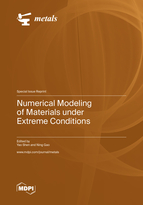Numerical Modeling of Materials under Extreme Conditions
A special issue of Metals (ISSN 2075-4701). This special issue belongs to the section "Computation and Simulation on Metals".
Deadline for manuscript submissions: closed (31 December 2022) | Viewed by 24854
Special Issue Editors
Interests: micromechanics of materials; plasticity and dislocation theory; mechanical behavior under extreme conditions
Interests: radiation effects; computer simulations; ion implantation experiments
Special Issues, Collections and Topics in MDPI journals
Special Issue Information
Dear Colleagues,
The responses of materials under extreme conditions are important in various industrial and defense fields. Experiments in the encountered conditions are often difficult and/or expensive. Consequently, numerical modeling of the material response is crucial for study in these fields. These and more will be explored in this Special Issue “Numerical Modeling of Materials Under Extreme Conditions” of the open access journal Metals, which is now open for submissions. Manuscripts are solicited for numerical work on material responses to extreme conditions such as, but not limited to, shock loading (high strain rate) by solid or laser impact, neutron or ion irradiation, high pressure and/or high temperature environment, etc. Various approaches and models to simulate the mechanical response and microstructural evolution during the processes, from atomic scale up to macroscale, are welcome. All material types relevant to these topics are welcome. Early submission is encouraged because publication is ongoing and, therefore, publication much earlier than the deadline of 31th December 2022 is possible.
Prof. Dr. Yao Shen
Prof. Dr. Ning Gao
Guest Editors
Manuscript Submission Information
Manuscripts should be submitted online at www.mdpi.com by registering and logging in to this website. Once you are registered, click here to go to the submission form. Manuscripts can be submitted until the deadline. All submissions that pass pre-check are peer-reviewed. Accepted papers will be published continuously in the journal (as soon as accepted) and will be listed together on the special issue website. Research articles, review articles as well as short communications are invited. For planned papers, a title and short abstract (about 100 words) can be sent to the Editorial Office for announcement on this website.
Submitted manuscripts should not have been published previously, nor be under consideration for publication elsewhere (except conference proceedings papers). All manuscripts are thoroughly refereed through a single-blind peer-review process. A guide for authors and other relevant information for submission of manuscripts is available on the Instructions for Authors page. Metals is an international peer-reviewed open access monthly journal published by MDPI.
Please visit the Instructions for Authors page before submitting a manuscript. The Article Processing Charge (APC) for publication in this open access journal is 2600 CHF (Swiss Francs). Submitted papers should be well formatted and use good English. Authors may use MDPI's English editing service prior to publication or during author revisions.
Keywords
- numerical modeling
- extreme conditions
- shock loading
- laser impact
- neutron irradiation
- ion irradiation
- high temperature
- high pressure
- multiscale modeling







